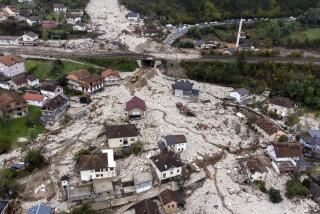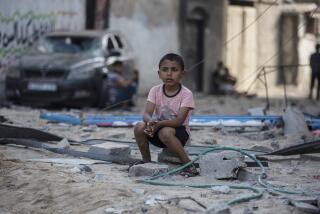Serbian Refugees Uneasy in the Role of Occupiers : Yugoslavia: Thousands are installed in ‘liberated’ Croatian homes in a bid by Belgrade to solidify its hold.
- Share via
BELI MANASTIR, Croatia — From the toy dump trucks and stuffed animals that her own son now plays with, Branka Balatinac can tell that the spacious house she occupies was once home to another small boy.
The two-story stucco villa was the property of a Croatian family driven out in September, when the Yugoslav army tanks rolled in.
Uncomfortable with the constant reminders that this home is not really hers, Balatinac has packed up the shoes, clothes and mementos of the former occupants and stashed them on top of a wardrobe, out of sight.
But she eats off their dishes and sleeps on their sheets and, now that it is frosty December, she has taken to wearing the last homemaker’s stylish black winter coat.
“I feel terrible being here,” the 33-year-old refugee wailed, smearing aside tears of embarrassment. “I feel like the worst kind of person having to do this, living in someone else’s house. But I left my own home with nothing but the clothes on my back.”
Serbian militants who have “liberated” this town and others across a wide swath of eastern Croatia have already billeted nearly 5,000 Serbian refugees in the homes of Croats who were confronted with the choice of taking on the army or taking flight.
The resettlement plan, devised in the Serbian capital of Belgrade, is the first step toward an eventual land exchange and forced migration to create an ethnically “pure” Serbian region to replace the mixed communities of eastern Croatia.
Serbian politicians and those claiming to govern the conquered Croatian territory have begun singing in unison the praises of redrawing boundaries to expand Serbia so that it can accommodate all Serbs, while ceding small Serbian villages deep inside Croatia to the rival Croats in return.
But the plans of Belgrade bureaucrats and occupation officials appear to have overlooked popular resistance. Many of those envisioned as new settlers of Greater Serbia are desperately unhappy in their unwanted new homes.
“This is not mine. I don’t want it. I want what is mine!” sobbed Balatinac. “I can never live here like I lived in my own home. If I can’t go back there, I’ll still want to forever, and I’ll raise my son to go back even if it takes 20 years.”
The Balatinac home is in the mainly Croatian town of Cepin, which has come under attack by the Serbian-led federal army in its campaign to take the nearby city of Osijek. Croatian nationalists have also fired on the home to punish Balatinac for her fellow Serbs’ aggression.
Serbs account for 600,000 of Croatia’s 5 million people. About one-third of them live in the region known as the Krajina, Croatia’s military frontier established centuries ago when Serbs fleeing Ottoman rule were given land along Austria’s southern border in exchange for defending the Hapsburg empire from Turkish attacks.
When Croatia declared its independence June 25, Krajina’s Serbs revolted against the republic’s secession from Yugoslavia, where Serbs are the largest and most influential ethnic group. Battles have since raged throughout Croatia between republic national guardsmen and the Serbian-commanded federal army, which claims to be protecting the Serbian minority from a fascist plot by the Croats to wipe them out.
With at least 7,000 dead and 500,000 homeless after five months of chaotic fighting, ethnic hatred has escalated to a fever pitch and poisoned relations between Serbs and Croats, many believe beyond repair.
“There’s no more chance of cultural autonomy or some separate status within Croatia. The only possibility for the future is redrawing of the borders,” insists Goran Hadjic, prime minister of the proclaimed Serbian province of Slavonija, Baranja and West Srem.
The Serbian leaders have begun busing in new settlers, who are taking over the houses, farms and apartments of the tens of thousands of Croats whom the army and local Serbian militants killed or expelled. They deny the resettlement is a violation of the Geneva Conventions, which prohibit occupation of conquered territory. Instead, they contend the move is only temporary until a negotiated peace treaty can be arranged to legalize the fait accompli .
There is also a precedent, the Serbs claim, for repopulation in the area around Beli Manastir. It was here that tens of thousands of ethnic Germans were expelled after World War II, drawing in Serbs and Croats forced to flee other areas of Yugoslavia that were the scenes of brutal massacres and retaliations.
“Future common life is impossible, and it is best for the Croats and for the Serbs to part in a peaceful manner and fix frontiers between them wherever possible,” said Jovan Ilic, a geography professor at Belgrade University.
Employing popular Serbian justifications for deeming huge areas of Croatia the rightful property of Serbs, Ilic has proposed to the Serbian government that new boundaries be drawn to better define the ethnic makeup.
His plan would grant the republic of Slovenia independence on its current territory but would recognize Croatia only after stripping it of rich eastern farmland and most of its renowned Adriatic Sea coast.
Belgrade officials overseeing the affairs of 180,000 Serbian refugees also argue that ethnic migration is the only viable alternative to a protracted and expanding Balkan war.
Serbs, who have always lived as a minority in the Baranja area that surrounds Beli Manastir, now contend that they will never be able to live side by side again with the Croats. They welcome the arrival of Serbian refugees to strengthen their hold on the territory and bolster defenses against the ever-present threat of Croatian retaliation to win the land back.
While the redistribution of abandoned Croatian houses serves the interests of Serbian expansionism, not all Serbs in Croatia are keen on moving.
Most of Croatia’s Serbian residents live in areas that are mainly Croatian, such as the republic’s capital of Zagreb, home to 140,000 Serbs.
Eastern Croatian cities such as Osijek and Vinkovci, both under federal bombardment, are needed to attract Serbs from big cities such as Zagreb and Rijeka, the Serbian leaders say in rationalizing the army onslaught.
About 8,000 Serbs from Zagreb have appealed to Belgrade’s refugee center for temporary shelter, fearing reprisals in the Croatian capital. But the vast majority of Zagreb’s Serbs remain in their homes, preferring the life they know over relocation to unfamiliar territory dubiously claimed as Serbian.
Tens of thousands of other Serbs live clustered in small communities but surrounded by Croatian towns and villages. They are the ones most likely to be forced into migration, as Belgrade and the army seem to have written off as hopeless their chances of holding every island of Serbs.
One of the isolated Serbian enclaves abandoned by the army was Grubisno Polje, about 60 miles east of Zagreb. Serbs joined the rebellion against Croatian rule, only to be disappointed that the army did not stay to defend them after initially routing Croatian forces.
Bloody reprisals drove thousands to abandon their homes and seek refuge in Belgrade, where local authorities have been busing them to the empty homes around Beli Manastir.
“They attacked us from all sides and burned our houses to the ground,” said 63-year-old Slavo Caric, blaming the Grubisno Polje battle on Croatian forces he calls Ustashe, referring to World War II-era fascists.
Other refugees from Grubisno Polje, however, have accused the army of burning them out. The weekly newsmagazine Vreme quoted several Serbs from the village who contend it was the army and Serbian irregulars who destroyed their homes.
The refugees claim Belgrade is trying to drive Serbs out of those areas of Croatia that cannot be annexed to Greater Serbia, forcing them to resettle in the conquered territories and thereby strengthening the Serbian hold on them. The empty and ruined villages like Grubisno Polje could then be “traded” to Croatia in return for the eastern territory Serbs already occupy.
Those claims have been bolstered by reports from European Community monitors in Croatia. They accuse a “cowardly army” of terrorizing civilians--forcing them out, then burning or bulldozing the abandoned villages to hide their looting.
Belgrade has helped local Serbs here and elsewhere in the conquered territory establish the new Serbian province that extends from the Hungarian border south along the Danube River and west to the roving front line.
George Latas, head of Baranja’s self-appointed regional council, said the settling of Serbs in abandoned Croatian homes around Beli Manastir is viewed as a temporary measure to house those made homeless by the war. “Because the clashes continue, we don’t know what kind of peace agreement will be reached at the end,” Latas said. “We don’t know yet if there will be a movement of Serbs to the east and Croats to the west.”
But those transported from homes damaged by relentless army shelling or deliberately destroyed to encourage migration see their new homes as permanent, since they have nowhere else to go.
“It would be easiest just to exchange houses,” said George Glumac, whose home was destroyed in Grubisno Polje. “I don’t know where the Croats will live, but that’s their problem. They are the ones who started this war.”
Until recently, Croats made homeless by the fighting were put up in coastal hotels or taken in by relatives in areas where the war has not yet spread.
While Serbs own many of the vacation homes along Croatia’s lucrative Adriatic coast, Belgrade has made clear it has no intention of trading those properties for the eastern Croatian farmland it now occupies. Conversely, geographer Ilic argues, Serbs have a right to two-thirds of Croatia’s coastline, extending as far north as the port of Zadar. Croats form a huge majority on the coast, but Ilic contends Yugoslav census figures are erroneous. Historical mistakes classified the coast’s residents as Croatian when they are actually “Catholic Serbs,” the geographer claims.
Croatian leaders have rejected the repopulation policy being pushed by the Serbs, accusing Belgrade of trying to justify a blatant aggression.
“They want to create an island of Serbian communities on the Croatian and Bosnian borders,” said Croatian Information Minister Branko Salaj.
But Zagreb officials, such as Deputy Prime Minister Mate Granic, vow that Croatia will not simply give up its land.
“There will be no discussion about one meter, one yard,” Granic said, rejecting Belgrade’s suggestion that the boundaries be redrawn to unite the Serbs.
With no end to the war in sight and Serbia now controlling one-third of Croatia’s territory, Zagreb may be forced to concede in areas such as Baranja that possession is the greater part of the law.
More to Read
Sign up for Essential California
The most important California stories and recommendations in your inbox every morning.
You may occasionally receive promotional content from the Los Angeles Times.











